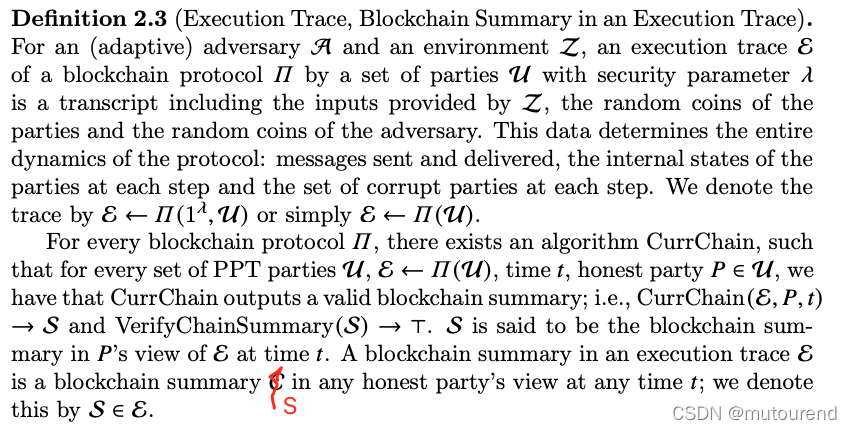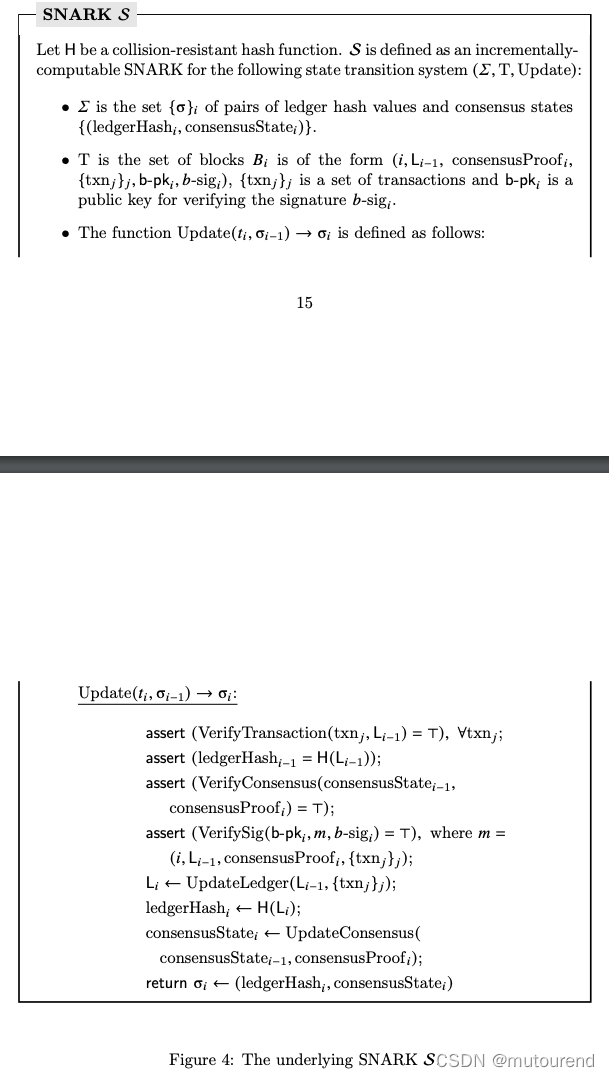1. 引言
Mina系列博客有:
- Mina概览
- Mina的支付流程
- Mina的zkApp
- Mina中的Pasta(Pallas和Vesta)曲线
- Mina中的Schnorr signature
- Mina中的Pickles SNARK
- Mina中的Kimchi SNARK
- Mina Kimchi SNARK 代码解析
- Mina Berkeley QANet测试网zkApp初体验
- Mina中的Poseidon hash
- Mina中的多项式承诺方案
- Recursive SNARKs总览
传统区块链验证 t t t笔交易所需时间为 Ω ( t ) \Omega(t) Ω(t),Mina致力于实现:从gennesis到当前的所有历史交易的验证时间为constant O ( 1 ) O(1) O(1)(约200ms),即与交易数无关,实现所谓的succinct blockchain。
具体实现方法为,在每个区块内包含state validity 的succinct proof。当前区块commit的system state,可看成是由genesis state,经一系列有效的交易所达成的,若当前区块有效,则这一系列交易可看成是相应的witness。
不过,若是为每个区块都从genesis开始创建所有历史交易的有效性证明,这样的proof计算将是昂贵的,为此,可借助incrementally computable SNARKs来确保为每个区块计算proof的开销,与自前一区块开始增加的交易数呈正比(即与当前区块所增加的交易数呈正比)。
Mina采用account模式,而不是UTXO模式,因此Mina链的当前状态为a list of all account balances。
在Mina的每个区块中,包含了:
- a commitment to this state (in a Merkle tree),而不是对所有state的commitment。为此,全节点无需存储整个state,但可根据当前最新区块头中的state commitment来高效验证account balances。
但是,Mina中的Prover(类似于Bitcoin中的miner),确实需要存储所有state,因为这些state作为witness,用于证明新区块的有效性。
Mina采用名为Ouroboros Samasika的proof-of-stake (PoS)共识机制。
当前,Mina的state proof size仅为864字节,验证时间约为200ms。任意支持这种级别计算的设备(如手机),都可在无需可信设备的情况下验证Mina系统的当前状态。
除incrementally computable SNARKs之外,Mina中采用了多种优化措施,其中最有效的优化措施有:
- 1)parallel scan state:从高层来看,这将提高交易吞吐量,使其超过顺序计算证明的限制。核心思想是对所有仍需要纳入证明的块排队,并将它们的证明分发给parallel Provers。引入最新交易的特殊队列:以将交易确认延迟降低到最小证明时间所施加的限制之下。
- 2)引入了一种特殊的激励结构,以最大限度地提高Prover在网络中的参与度。

2. succinct blockchains
2.0 相关定义
PPT:probabilistic polynomial time
λ \lambda λ:表示安全参数。
SNARKs定义为:

Signature of Knowledge (SoK):为数字签名的通用表达,将公钥替换为NP language中的an instance,正式的定义参见Groth和Maller 2017年论文Snarky Signatures: Minimal Signatures of Knowledge from Simulation-Extractable SNARKs。SoK的概念与simulation-extractable non-interactive zero-knowledge argument的概念相关。在Mina中,依赖使用SNARKs构建的SoKs,从而可利用SoK的succinctness。(Mina采用的是Bowe和Gabizon 2018年论文《Making groth’s zk-snark simulation extractable in the random oracle model》中的simulation-extractable SNARK方案。)
定义2.1:
- state:为a string s t ∈ { 0 , 1 } λ st\in\{0,1\}^{\lambda} st∈{ 0,1}λ
- block proof:为a value (或a set of values) π i B \pi_i^B πiB,包含了用于验证该区块是否有效的信息。
- block:每个区块关联一个称为block producer的唯一一方。block B i = { s n i , s t i , π i B , d i , b-pk i , b-sig i } B_i=\{sn_i, st_i,\pi_i^B, d_i,\text{b-pk}_i,\text{ b-sig}_i\} Bi={ sni,sti,πiB,di,b-pki, b-sigi},其中 s n i ∈ N sn_i\in\mathbb{N} sni∈N为serial number, s t i st_i sti为当前state, π i B \pi_i^B πiB为当前block proof, d i ∈ { 0 , 1 } ∗ d_i\in\{0,1\}^* di∈{ 0,1}∗为当前block data, b-pk i \text{b-pk}_i b-pki为当前block producer的公钥, b-sig i \text{b-sig}_i b-sigi为当前公钥 b-pk i \text{b-pk}_i b-pki对 { s n i , s t i , π i B , d i } \{sn_i, st_i,\pi_i^B, d_i\} { sni,sti,πiB,di}的签名。
Mina链由一系列区块 C = { B 1 , ⋯ , B n } C=\{B_1,\cdots,B_n\} C={ B1,⋯,Bn}组成,其中序列号为严格单调递增的。第一个区块 B 1 B_1 B1称为genesis block。 len ( C ) = n \text{len}(C)=n len(C)=n为当前区块高度。
定义2.2:
succinct blockchain protocol Π \Pi Π由5个PPT算法组成 ( VerifyConsensus, UpdateConsensus, VerifyBlock, UpdateChainSummary, VerifyChainSummary ) (\text{VerifyConsensus, UpdateConsensus, VerifyBlock, UpdateChainSummary, VerifyChainSummary}) (VerifyConsensus, UpdateConsensus, VerifyBlock, UpdateChainSummary, VerifyChainSummary):
- VerifyConsensus(consensusState, consensusProof) → ⊤ / ⊥ \text{VerifyConsensus(consensusState, consensusProof)}\rightarrow \top/\perp VerifyConsensus(consensusState, consensusProof)→⊤/⊥:该算法的输入为 consensusState 和 consensusProof \text{consensusState 和 consensusProof} consensusState 和 consensusProof,验证某个正确性与否分别输出 ⊤ 或 ⊥ \top或\perp ⊤或⊥。
- UpdateConsensus(consensusState, consensusProof) → nextConsensusState \text{UpdateConsensus(consensusState, consensusProof)}\rightarrow \text{nextConsensusState} UpdateConsensus(consensusState, consensusProof)→nextConsensusState:该算法的输入也为 consensusState 和 consensusProof \text{consensusState 和 consensusProof} consensusState 和 consensusProof,输出为an updated consensus state。
- VerifyChainSummary ( S i ) → ⊤ / ⊥ \text{VerifyChainSummary}(S_i)\rightarrow \top/\perp VerifyChainSummary(Si)→⊤/⊥:该算法验证某blockchain summary S i S_i Si是否有效。
- VerifyBlock ( S i − 1 , B i ) → ⊤ / ⊥ \text{VerifyBlock}(S_{i-1}, B_i)\rightarrow \top/\perp VerifyBlock(Si−1,Bi)→⊤/⊥:该算法验证某区块 B i B_i Bi是否对应某blockchain summary S i − 1 S_{i-1} Si−1有效。作为验证的一部分,它会检查 VerifyConsensus(consensusState i − 1 , consensusProof i ) → ⊤ \text{VerifyConsensus(consensusState}_{i-1}, \text{consensusProof}_i)\rightarrow \top VerifyConsensus(consensusStatei−1,consensusProofi)→⊤,其中 S i − 1 S_{i-1} Si−1包含了 consensusState i − 1 \text{consensusState}_{i-1} consensusStatei−1, π i B \pi_i^B πiB包含了 consensusProof i \text{consensusProof}_i consensusProofi, B i = ( ⋅ , ⋅ , π i B , ⋅ , ⋅ , ⋅ ) B_i=(\cdot,\cdot,\pi_i^B,\cdot,\cdot,\cdot) Bi=(⋅,⋅,πiB,⋅,⋅,⋅)。
- UpdateChainSummary ( S i − 1 , B i ) → S i \text{UpdateChainSummary}(S_{i-1}, B_i)\rightarrow S_i UpdateChainSummary(Si−1,Bi)→Si:该算法输入为blockchain summary S i − 1 S_{i-1} Si−1和新区块 B i B_i Bi,输出为an updated blockchain summary S i S_i Si。
以上succinct blockchain protocol Π \Pi Π具有succinctness属性:
- 所谓succinctness,是指: ( VerifyConsensus, VerifyBlock, VerifyChainSummary ) (\text{VerifyConsensus, VerifyBlock, VerifyChainSummary}) (VerifyConsensus, VerifyBlock, VerifyChainSummary) 算法的运行时间为 poly ( λ ) \text{poly}(\lambda) poly(λ),此外,任意时间 t i t_i ti的blockchain summary S i S_i Si的size为 poly ( λ ) \text{poly}(\lambda) poly(λ)(即,constant in the number of chain summary updates)。
Remark 2.1:
共识机制:算法对 (VerifyConsensus, UpdateConsensus) \text{(VerifyConsensus, UpdateConsensus)} (VerifyConsensus, UpdateConsensus) 构成共识机制。
- 对于proof-of-work protocol(如Bitcoin):consensus sate中将包含多个之前的difficulty targets和block times(from which to compute the current difficulty target)。其consensus proof中将包含the proof-of-work itself以及a new to update the state with。
- 对于Ouroboros Praos类型的proof-of-stake机制:consensus state中将包含当前的random seed、当前epoch的stakes的Merkle root、之前区块和block times的某些信息。其consensus proof中将包含(满足consensus state中目标阈值要求的)一个公钥 和 一个verifiable random function (VRF) evaluation proof。
succinct blockchain中包含3个角色:
- 1)全节点:跟踪和验证blockchain summary的一方。具有合理资源的任意人都称为全节点。也就是说,不需要轻节点的角色来应对不断增长的区块链规模。
- 2)产块者:负责产块的一方。
- 3)产blockchain summary:负责生成blockchain summary的一方。
blockchain summary与底层链之间的关系为:
- a summary is valid 当且仅当 the underlying blockchain is valid。
- 根据blockchain summary,可通过extractability获得相应的底层链。
特别定义了递归提取:即已知serial number 为 i i i的某blockchain summary,an extractor(额外利用某些信息)可提取出序列化为 i − 1 i-1 i−1的blockchain summary和区块 B i B_i Bi,使得满足相应的验证测试。此处extractor所使用的额外信息称为execution trace,定义为:



2.1 succinct blockchain的安全属性
已知blockchain protocol Π \Pi Π和execution ε \varepsilon ε,令blockchain summary S S S in ε \varepsilon ε的底层链为 C C C,则相应的安全属性有:

3. Mina:为基于Recursive SNARKs的succinct blockchain
Recursive SNARKs又名“incrementally-computable SNARKs”,相关论文有:
- [23] Valiant 2008年论文 Incrementally verifiable computation or proofs of knowledge imply time/space efficiency
- [7] Bitansky等人2012年论文Recursive composition and bootstrapping for SNARKS and proof-carrying data
- [5] Ben-Sasson等人2014年论文Scalable zero knowledge via cycles of elliptic curves
3.1 incrementally-computable SNARKs
不同于[23]中的incrementally-computable SNARKs概念 和 [7\5]中的proof-carrying data (PCD)概念,为便于表述succinct blockchain,采用state-transition system概念:

即具有 poly ( λ ) \text{poly}(\lambda) poly(λ)-size proof(验证时间也为 poly ( λ ) \text{poly}(\lambda) poly(λ))来证明如下statement:
- 存在state σ 1 \sigma_1 σ1 和 一系列transitions t 1 , ⋯ , t k ∈ T t_1,\cdots,t_k\in T t1,⋯,tk∈T,使得 Update ( t k , Update ( t k − 1 , ⋯ , Update ( t 1 , σ 1 ) ) ) = σ 2 \text{Update}(t_k,\text{Update}(t_{k-1}, \cdots, \text{Update}(t_1,\sigma_1)))=\sigma_2 Update(tk,Update(tk−1,⋯,Update(t1,σ1)))=σ2成立。
换句话说,就是存在一组state-transition来连接2个state。对于succinct blockchain,可将state看成是account数据库(以及正确验证新区块所需的某些metadata),将transition看成是区块。
定义4.2:
针对state transition system ( ∑ , T , Update ) (\sum, T,\text{Update}) (∑,T,Update)的incrementally-computable SNARKs中包含了一组算法 (sSetup, sProve, sVerify, sSim) \text{(sSetup, sProve, sVerify, sSim)} (sSetup, sProve, sVerify, sSim):

3.1.1 采用Recursive Proof Composition的Incrementally-computable SNARKs
Mina借助了[5] Ben-Sasson等人2014年论文Scalable zero knowledge via cycles of elliptic curves中的“cycle of elliptic curves”技术,构建了2个SNARKs:
- Tick SNARKs:
- Tock SNARKs:
Tick SNARKs和Tock SNARKs可相互高效verify对方的proof:
- Tick SNARKs可高效验证Tock proof
- Tock SNARKs可高效验证Tick proof
然后Mina将Tick SNARKs和Tock SNARKs定义为a “binary tree of proofs”:
- 1)Tick SNARK:用于证明state transition at the “base” of the tree。
- 2)采用Tock SNARK来包裹步骤1)中的Tick SNARK。
- 3)采用Tick SNARK来将步骤2)中的2个Tock SNARK进行合并。
即整个过程中存在2个Tick SNARKs:
- 一个Tick SNARK用于证明state transition
- 一个Tick SNARK用于合并2个Tock proof
详细定义为:

3.1.2 transition system示例
以初始状态为 x x x,经 k k k次hash运算后的当前状态 x ′ = H ( H ( ⋯ H ( x ) ) ) x'=H(H(\cdots H(x))) x′=H(H(⋯H(x)))为例,对应定义4.1中,state ∑ \sum ∑为the union of domain and range of H H H, T T T为a singleton set containing an empty string,相应的update函数为 Update(t,x) = H ( x ) \text{Update(t,x)}=H(x) Update(t,x)=H(x)。
相当于需使用SNARK来证明:
存在一系列transition ( t 1 , ⋯ , t k ) (t_1,\cdots,t_k) (t1,⋯,tk),使得 Update ( t k − 1 , ⋯ , Update ( t 1 , x ) ) = x ′ \text{Update}(t_{k-1},\cdots,\text{Update}(t_1,x))=x' Update(tk−1,⋯,Update(t1,x))=x′,其中 Update(t,y) = H ( y ) \text{Update(t,y)}=H(y) Update(t,y)=H(y)。
令 k = 4 k=4 k=4,状态 x 0 , x 4 x_0,x_4 x0,x4满足 H ( H ( H ( H ( x 0 ) ) ) ) = x 4 H(H(H(H(x_0))))=x_4 H(H(H(H(x0))))=x4,相应的SNARK proofs组成的tree为:

3.2 Mina:采用Incrementally-computable SNARKs的succinct blockchain
可将blockchain updates看成是state transition system,从而可使用incrementally-computable SNARKs来构建succinct blockchain。
3.2.1 构建Mina协议

4. The Mina Protocol for Payment
在本节,将专注于支付应用场景,每一方都有具有一定balance的account,交易为将一方的balance转到另一方的账号。
4.1 用于支付的Mina框架
令 U \mathcal{U} U为Mina网络中的各方集合,Mina框架中包含以下概念:
- 账号:每方都有一个账号,标记为 (pk, balance,nonce) \text{(pk, balance,nonce)} (pk, balance,nonce),其中 pk \text{pk} pk为该放的公钥,用于支付认证,balance ∈ N \in\mathbb{N} ∈N,nonce ∈ I \in\mathbb{I} ∈I用于防止交易重放。
- 账本:将账本定义为所有账号的集合。通过 L(pk) \text{L(pk)} L(pk)来引用某账号,通过类似 L(pk).balance \text{L(pk).balance} L(pk).balance来访问该账号的balance。
- 交易:交易为将Sender account的 L(pk s ).balance \text{L(pk}_s\text{).balance} L(pks).balance 中的 amt \text{amt} amt 个值 转移给Receiver的账号 L(pk r ).balance \text{L(pk}_r\text{).balance} L(pkr).balance。将该交易表示为 txn=(pk s , pk r , amt, nonce s , sig s ) \text{txn=(pk}_s\text{, pk}_r\text{, amt, nonce}_s\text{, sig}_s\text{)} txn=(pks, pkr, amt, nonces, sigs),其中 pk s , pk r \text{pk}_s, \text{pk}_r pks,pkr分别为发送者和接收者的公钥, nonce s \text{nonce}_s nonces为发送者账号的nonce值, sig s \text{sig}_s sigs为发送者对 ( pk r , amt, nonce s ) (\text{pk}_r,\text{amt, nonce}_s) (pkr,amt, nonces)的签名。
- 交易验证:已知交易 txn \text{txn} txn和账本 L \text{L} L,验证该交易有效性的算法为:

- 账本更新:已知账本 L \text{L} L和一组交易 { txn=(pk s , pk r , amt, nonce s , sig s ) } \{\text{txn=(pk}_s\text{, pk}_r\text{, amt, nonce}_s\text{, sig}_s\text{)}\} {
txn=(pks, pkr, amt, nonces, sigs)},更新账本的算法流程为:

4.2 Mina中的SNARK S S S
与定义4.2对应,Mina中的incrementally-computable SNARK定义为:

4.3 针对支付构建的Mina协议
令 (VerifyConsensus, UpdateConsensus) \text{(VerifyConsensus, UpdateConsensus)} (VerifyConsensus, UpdateConsensus)为Ouroboros Samasika共识机制, H H H为防碰撞哈希函数。

5. Snark Workers
Mina中引入了2种优化:
- 1)parallel scan state
- 2)prover incentives
以上2种优化策略都是为了解决以下问题:
- 由图3可知,需要 S i − 1 S_{i-1} Si−1来计算 S i S_i Si,从而有sequential dependency for SNARK proof computation,直观实现的化,会使block time至少为计算proof所需的事件。此外,block proposers由于有高的交易延迟(所谓交易延迟,是指交易打包进入a SNARK proof所需的延迟时间)需要消耗高内存。
采用以上2种优化策略的目的是使交易吞吐量最大化:最大限度地提高交易处理和验证的速度,使网络上有更多同时使用的用户。
5.1 Parallel Scan State
raw blockchain中的区块本质是顺序的(即通常区块无法并行)。但是借助SNARK中的incremental computability,SNARK的生成可并行化——通过将产块和计算SNARK这2部分解耦,来实现parallel scan state。
在Mina中,维护了一种特殊的队列,名为:work queue,当有新的区块proposed时,会将该新区块塞入work queue中。也就是说,网络中需要执行a queue of the ‘SNARK work’。
然后网络并行计算SNARK proofs:
- 会计算出一个a tree of proofs,该tree的叶子节点对应the proofs proving validity of single blocks,其它proofs用于简单地证明the correctness of their children proofs。
- 最终,root proof用于证明the correctness of all the blocks corresponding to the leaves of the tree。
比如,假设work queue中有一系列的区块 B i , B i + 1 , ⋯ , B j B_i,B_{i+1},\cdots,B_j Bi,Bi+1,⋯,Bj。root proof可证明the validity of each of blocks。将该root proof与证明 S i − 1 S_{i-1} Si−1有效性的SNARK proof结合,可生成用于证明the validity of S j S_j Sj的SNARK proof。如下图所示。下图中的tree,其本质与“transition system示例”的transition系统类似。

由此可见,通过仔细设计并行机制,可优化保证吞吐量能跟上交易增加的速度。直观方案中,交易延迟为 O ( R ) O(R) O(R),其中 R R R为产块rate,而借助以上优化,交易延迟减为 O ( log ( R ) ) O(\log(R)) O(log(R))。
通过仔细设计数据结构,还可减少存储需求。直观方案中的存储为 O ( R ) O(R) O(R),上述优化后存储需求为 2 R − 1 + O ( 1 ) 2R-1+O(1) 2R−1+O(1)。
5.2 对Prover激励
生成SANRK proofs的一方称为snarker。通过对Prover激励来实现尽可能低的交易延迟(即减少区块生成 与 该区块被吸入到链的SNARK proof中 的时间差)。
提供的Prover激励结构如下:
- 每个产块者将一个区块push到work queue时,要求pop一个区块来为其生成a proof validating the block。产块者会提交一个fee request和其所生成的SNARK proof,同时在同一个区块中包含一笔向(为该区块计算snark的)Prover支付fee的交易。通常情况下,这些费用是从产块者可能收到的交易费用中支付的。
本质上,每件SNARK work piece都有最低价格的拍卖。产块者希望为他们的proofs给snarkers支付尽可能低的费用,而snarkers希望为他们的proofs收取尽可能高的费用。因此,强制产块者同时也是(不同区块的)Prover,可强化系统的稳定性。
注意,这与直观方案中产块者同时要计算SNARK proof类似,但是,不同之处在于,产块者为work queue head的区块计算proof,而不是为其所产区块计算proof。
Remark 6.1:
已知a proof和相应的fee request,要求adversary不能对该fee request进行抨击,否则,攻击者可pass-off a different party’s proof as their own (by replacing the public key) (即占用别人的成果)或者修改某人的fee request。
借助signature of knowledge密码学原语可实现该功能。Mina采用的是Bowe和Gabizon 2018年论文《Making groth’s zk-snark simulation extractable in the random oracle model》中的simulation-extractable SNARK方案。
6. Ouroboros Samasika——succinct blockchain的PoS共识
针对constant-size succinct blockchain,共识中需要考虑以下2个分叉场景:
- 1)Short-range fork rule:仅需要选择最长链。
- 2)Long-range fork rule:adversary创建分叉并长期施加作用——如可能歪曲了leader selection从而创建了更长的adversarial chain。需要以依赖分叉伊始的少量几个slot中的density difference来选择分叉链。

Mina中每个epoch有 R R R个slots,某些slot可为空(即没有任何区块与其关联)。特别地,共识参数 f f f,表示the probability that any given slot has a block producer assigned to it。若没有产块者给某slot赋值,则该slot为空(即没有block)。【如令 k = 10 , f = 0.5 , R = 240 k=10,f=0.5,R=240 k=10,f=0.5,R=240】
Mina的共识协议中定义了3种参与方:
- Alert parties:可访问所有所需资源,并同步。Alert parties享有full security guarantees,可要求相对低的质押来保证安全。
- Potentially active parities(简称为active):只在协议执行过程中,可能会参与当前time slot的所有方。
- Inactive parties:如因网络连接等无法访问参与协议所需资源的各方。
6.1 epoch随机值及leader选举
epoch ep \text{ep} ep中所考虑的质押分布通常是epoch ep-2 \text{ep-2} ep-2的最后一个slot内的质押分布。处理质押分布,epoch随机值也会影响任意epoch的leader选举。特别地,epoch随机值派生自epoch ep-1 \text{ep-1} ep-1前2/3的特定区块信息。【将一个epoch前2/3区块的最后一个区块称为“lock checkpoint”,一个epoch的第一个区块称为“start checkpoint”。】
